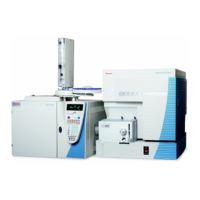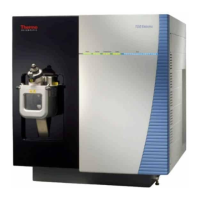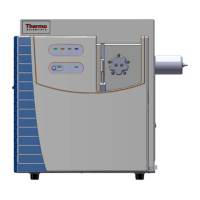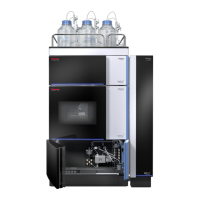2
Functional Description
Mass Spectrometer
32 TSQ Series Hardware Manual Thermo Scientific
Mass Analysis
The mass analyzers (Q1 and Q3) are square arrays of precision-machined and
precision-aligned hyperbolic or round-profile rods. The rods are charged with a variable ratio
of rf voltage and dc voltage (Figure 28). These potentials give rise to an electrostatic field that
gives stable oscillations to ions with a specific mass-to-charge ratio and unstable oscillations to
all others.
At any given instant, one particular set of rf and dc voltage values is being applied to the mass
analyzer rods. Under these conditions, only ions of one mass-to-charge ratio (for example,
m/z 180) are maintained within bounded oscillations as their velocity carries them through
the mass analyzer. At the same time, all other ions undergo unbounded oscillations. These
ions strike one of the rod surfaces, become neutralized, and are pumped away, or they are
ejected from the rod assembly.
Then, at a later time, both rf and dc voltages change, and ions of the next mass-to-charge ratio
(for example, m/z 181) are allowed to pass, while all other ions (including m/z 180) become
unstable and undergo unbounded oscillations. This process continues, with ions of one
mass-to-charge ratio after another being transmitted, as the rf and dc voltages change in value.
At the end of the scan, the rf and dc voltages are discharged to zero, and the process repeats.
The TSQ system can rapidly and precisely change the potentials on the quadrupole rods. The
rf and dc voltages in the TSQ mass spectrometer can be scanned over the full mass range of
the system, m/z 10 to 3000, in 0.85 seconds.
The more closely the electrostatic field generated by a set of quadrupole rods approximates a
hyperbolic geometry, the better their operating characteristics are. As a result, the precision
quadrupole rods of the TSQ mass spectrometer provide excellent sensitivity, peak shape,
resolution, and high mass transmission.
Collision Cell and CID Efficiency
In the MS/MS scan modes, the TSQ mass spectrometer applies a large voltage of opposite
polarity to the rod pairs between scans, which empties the collision cell. This process ensures
that no ions remain in the collision cell from scan to scan.
The collision cell quadrupole rod assembly (Q2), which always acts as an ion transmission
device, is a quadrupole array of square-profile rods. A variable rf voltage charges the rods,
which creates an electrostatic field that gives stable oscillations to ions in a wide window of
mass-to-charge ratios.
The collision cell surrounds Q2 and is usually pressurized from about 1 × 10
-3
to 4 × 10
-3
To rr
with argon collision gas. The collision cell is where collision-induced dissociation takes place.
CID is a process in which an ion collides with a neutral atom or molecule and then, because
of the collision, dissociates into smaller fragments. The mechanism of dissociation involves
converting some of the translational kinetic energy (TKE) of the ion into internal energy. This
collision places the ion in an excited state. If the internal energy is sufficient, the ion
fragments.

